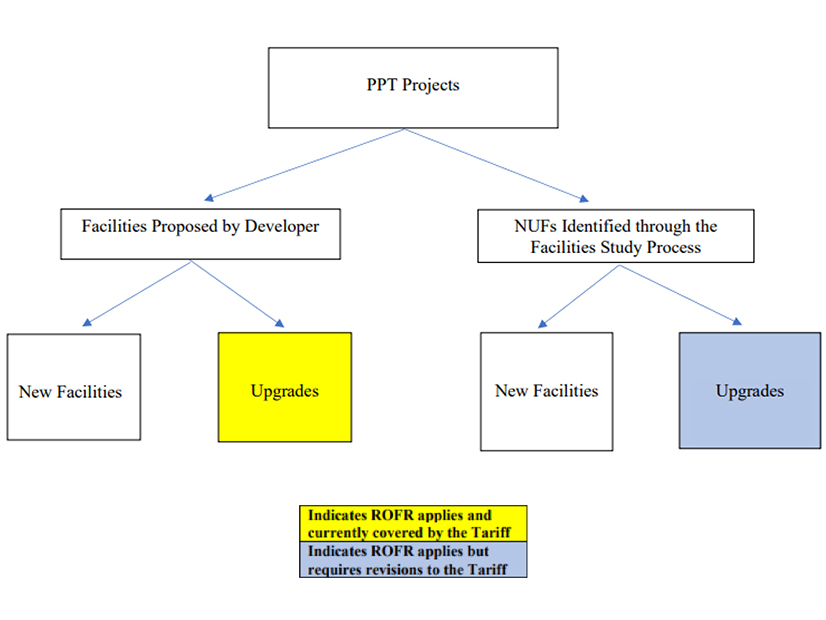New York transmission owners have proposed tariff amendments that would clarify their ability to exercise a right of first refusal (ROFR) for public policy transmission (PPT) network upgrade facility (NUF) upgrades identified in the interconnection study process.
FERC in March approved tariff changes that confirmed TOs could exercise a ROFR for upgrades that are proposed by other developers, but they lacked provisions on whether this applied to upgrades identified later by NYISO as necessary to reliably interconnect a project (EL22-2-001). (See FERC Approves ROFR for NY Transmission Upgrades.)
The Operating Committee on Thursday recommended that the Management Committee and Board of Directors authorize NYISO to file the proposed revisions, presented at the meeting by Stu Caplan, partner at Troutman Pepper, which represents the eight TOs.
In a statement to RTO Insider, Caplan said the proposed revisions would “merely apply a similar mechanism to upgrades that are identified in the interconnection process for the public policy transmission projects that are selected by the NYISO board.”
The revisions are the “logical extension of the process FERC approved in March of this year for upgrades identified at the project proposal stage,” he said.
Caplan told stakeholders that the proposal would replace a bilateral process that lacks certainty and timelines, provide for a transparent process that closely replicates approved standards, and define the ISO’s role in identifying which of the NUF components might qualify as an “upgrade” subject to a ROFR.
The TOs also want to make sure the rules are clear amid NYISO’s ongoing PPT project solicitation for interconnecting offshore wind. (See “Offshore Wind,” NYISO Stakeholders Propose Three Areas for Public Policy Transmission.)
“It is the only current solicitation for a public policy transmission projects, and the first project that may result in the identification of upgrades in the interconnection process for a public policy transmission project,” Caplan said.
During Wednesday’s Business Issues Committee meeting — where the proposal was also presented — Howard Fromer, who represents the Bayonne Energy Center, asked whether NYISO had expressed support for the changes.
Caplan answered that the ISO has said the TOs are “free to carry this forward as a TO-led effort.”
This response was followed up by NYISO attorney Brian Hodgdon, who said that “nothing has jumped out as an immediate concern” to the ISO.
The proposed amendments now move to the Nov. 30 MC meeting for approval.
Winter Capacity Assessment
NYISO expects sufficient capacity margins for this winter but anticipates continued year-to-year declines as more fossil fuel generators retire.
The ISO told stakeholders that that they expect a total of 477 MW worth of generation to be deactivated and a total of 672 MW of new generation to be added during the upcoming seasonal assessment period.
SRIS Scopes Amended
The OC unanimously approved revisions to the system reliability impact study (SRIS) scopes for 35 generation projects, which the ISO identified as possessing evaluations that could either be removed, were redundant or could be conducted later.
NYISO had recommended that these previously OC-approved SRIS scopes be narrowed to expedite interconnection processes and streamline transmission studies (See NYISO Identifies 35 Projects for Narrowed SRIS Scope.)
Intermittent Resources Update
For the first time, NYISO shared the total nameplate value of installed intermittent power resources in the New York Control Area:
- Land-based wind: 2,191 MW
- Behind-the-meter solar: 4,123 MW
- Front-of-the-meter solar: 74 MW
NYISO promised to expand this list to more intermittent resources, such as OSW, as they are installed in greater amounts, and promised to consider including battery storage in the future.
BIC & OC Elections
NYISO stakeholders unanimously elected Scott Leuthauser of Hydro Quebec Energy Services and Greg Yozzo of Central Hudson Gas & Electric as the new vice chairs of the BIC and OC, respectively.
[Editor’s Note: An earlier version of this article incorrectly attributed Brian Hodgdon’s quote to Brian Hurysz.]


